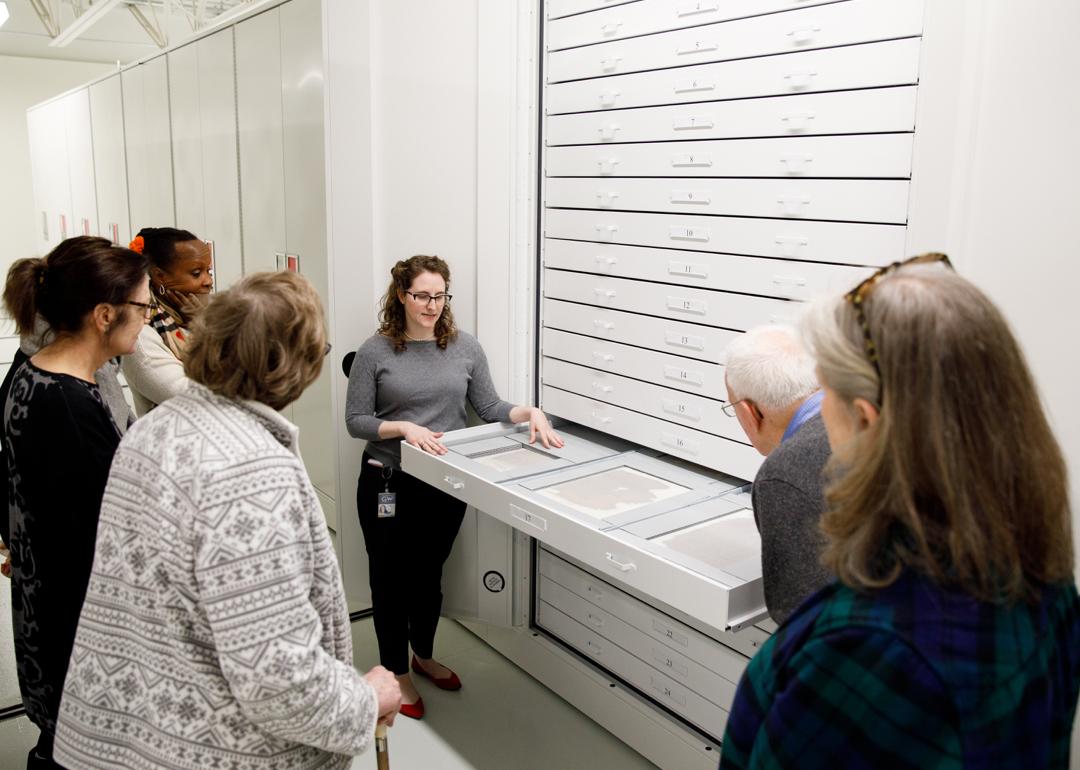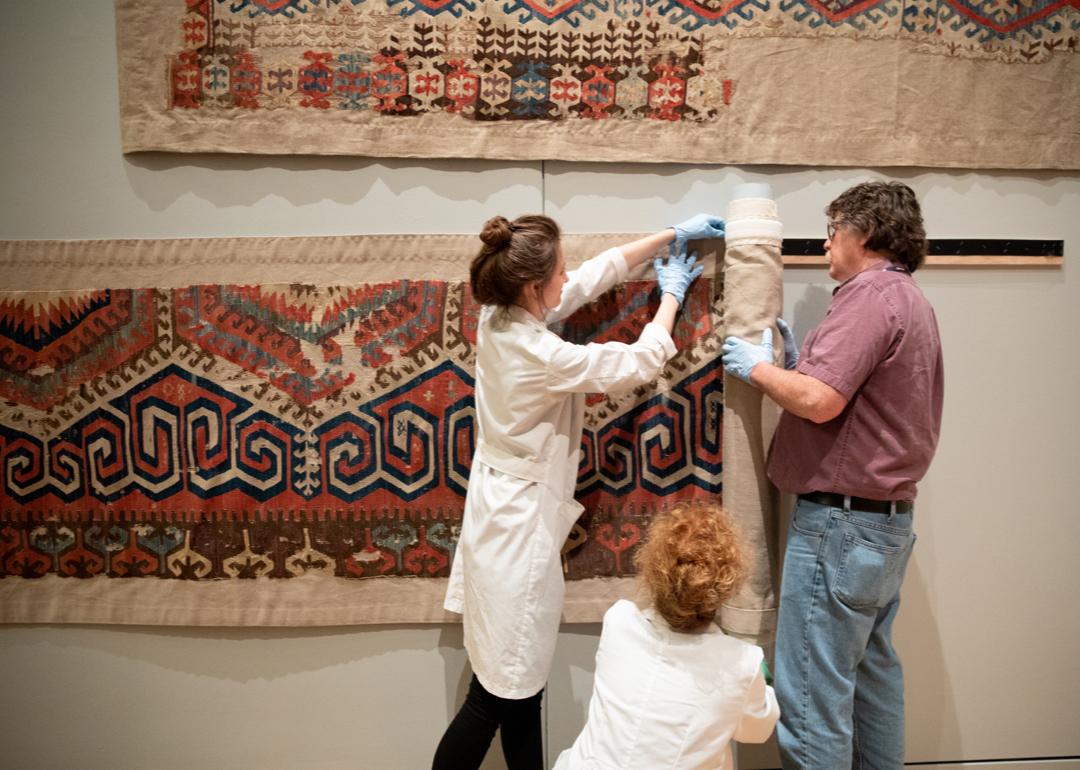Caring for Textiles
These guidelines and videos address some of the unique challenges of textile care. Textiles are threatened by environmental factors such as light, temperature, humidity, dust, insects and improper display or storage. Our recommendations can help extend the life and vibrancy of your collection.
Handling Textiles
Be sure to wash your hands before handling your collection pieces to remove oils, acids, salts and soils that can stain. If there is a chance your textile has been exposed to pesticides, wearing nitrile gloves is advised. (Common pesticides include naphthalene and paradichlorobenzene in mothballs, and dichlorvos in Vapona strips.) A textile can be easily torn if handled improperly. Remove jewelry, such as rings, that might catch on loose threads. Work on a clean surface and do not eat, drink or smoke around your textile collection. When moving a textile, gently pleat, fold or roll the piece and support its weight on a tray or a sturdy piece of cardboard.
Environmental Control
- Light
-
Light is one of the greatest threats to textiles. The most serious damage is caused by ultraviolet (UV) radiation from natural daylight and from fluorescent and halogen light bulbs. However, while UV rays cause the most rapid damage, the entire light spectrum fades textile dyes and causes fibers to become brittle. This includes plain incandescent light and, to a lesser degree, LED interior lighting. Keeping window shades pulled down or shutters closed during the sunniest times of day offers some protection. UV-filtering materials or films can be placed over windows and fluorescent bulbs, and are frequently used in the glass or acrylic that covers framed textiles.
Perhaps the most important rule of thumb is to display textiles for limited periods of time. Seasonal rotations are ideal: Display a textile for four months and then allow it to "rest" in dark storage for the remainder of the year. This method of care allows you to exhibit multiple textiles while extending the life of each one.
- Temperature & Humidity
-
High temperatures and humidity accelerate the deterioration of textiles and provide a hospitable environment for insects, mold and mildew. A climate of 65 to 70°F and 40 to 50 percent relative humidity is considered ideal for textiles.
However, it is most important to maintain a stable environment with as little fluctuation as possible. Temperature can be controlled with central heating and air-conditioning systems. You can supplement these with window units or space heaters for individual rooms. Humidity can be modified with humidifiers or dehumidifiers. Fans and a constant flow of air can also help prevent mold and mildew. If you catch mold and mildew in an early stage (before staining has set), move your textile to a more stable environment and contact a conservator immediately. If your textiles get wet from a leak or high humidity, immediately remove excess moisture by gently blotting or rolling them in white toweling, and then continue drying with a fan.
- Air Pollution
-
Air pollution is also an enemy of textiles. Sulfur dioxide fumes from cars and industrial facilities affect dyes, but simple dirt and dust may be a bigger threat to your collection. Dust particles are abrasive and cut into fibers as textiles expand and contract in response to fluctuations in humidity. A regular schedule of inspection and vacuuming is necessary to maintain textiles displayed without protective frames.
Cleaning Textiles
It seems natural to clean textiles to maintain their condition. However, while this is appropriate for your everyday pieces and household linens, in general you should not attempt to clean a historical textile without first consulting a textile conservator.
Proper cleaning techniques for historical textiles require a great deal of skill and experience. In fact, sometimes cleaning can be more harmful than allowing the textile to remain soiled. A conservator can evaluate the condition of the textile and assist you in determining the best course of action.
One important kind of cleaning you can do to maintain your textile collection is vacuuming. A low-suction HEPA-filtered vacuum with a hose attachment is the best tool for the job. Lightweight or fragile textiles should be vacuumed through a fiberglass screen (available at hardware stores). Vacuum slowly and carefully, working in the direction of the nap with velvets or other pile fabrics. Lift the vacuum nozzle in an up-and-down tamping motion; avoid scrubbing back and forth. If you have a rug in constant use on the floor, make sure to vacuum the back as well as the front on a regular basis.
Video: Should my textile be cleaned?
Video: What cleaning or maintenance can I undertake on my own?
Video: How can my textile be repaired?
Pest Treatment
If you have a rare textile, consider its condition before you treat it. Ask a conservator for professional advice.
- Freezing
-
Freezing is an effective and safe method for eradicating an insect infestation. To use freezing to get rid of insects:
-
Roll or fold the infested textile.
-
Wrap it in clean, clear polyethylene sheeting (3–4 mil).
-
Remove excess air to prevent risk of condensation in the package, but avoid damaging the textile by compressing it too much.
-
Seal the package with duct tape (other tapes such as masking or packing tape do not hold their seal during the freezing process).
-
Small textiles can be frozen in heavy weight food-grade zipper bags (freezer-rated zipper bags rather than storage zipper bags).
-
Place the packaged textile in a chest freezer for a minimum of one week. Most refrigerator freezers do not reach the necessary low temperatures of -4 to -13°F (-20 to -25°C).
-
It is imperative that the freezer not be opened at any time during this process in order to maintain a constant temperature.
-
After freezing, allow the textile to completely thaw before removing it from the package. Condensation will appear, but only on the outside of the package.
-
Inspect the textile carefully. One round of freezing is generally adequate. Two rounds of freezing as a routine is no longer standard practice, however if you are not certain everything has been killed, bring the textile back to room temperature and then repeat the procedure.
-
Carefully vacuum the textile (see Cleaning Textiles) to remove frass and other insect debris before returning it to display or storage
-
- Routine Pest Control
-
Good housekeeping is essential in preventing any kind of infestation. We recommend following these guidelines:
-
Periodically inspect textiles and storage areas for evidence of insects.
-
Cover windows, air ducts and chimneys with screens to prevent the entry of flying insects.
-
Storage area should be dry and clean.
-
Regularly vacuum the storage or display area to avoid any accumulation of dust and dirt that can attract insects.
-
Proper air circulation, 40 to 50 percent relative humidity, and a temperature of 68 to 72°F in storage areas will prevent mold and mildew
-





